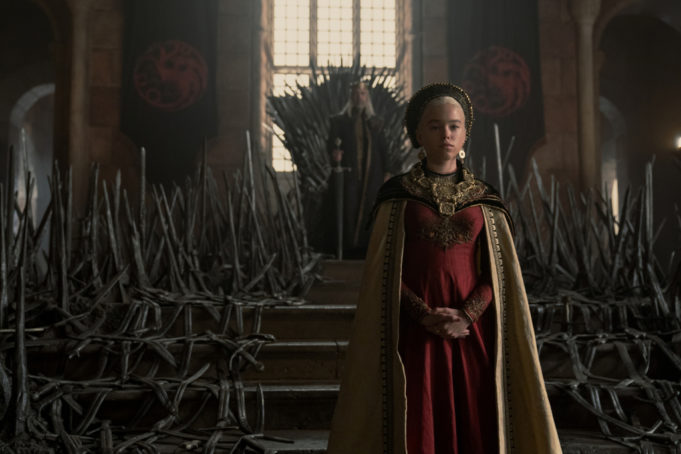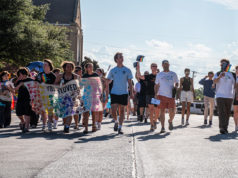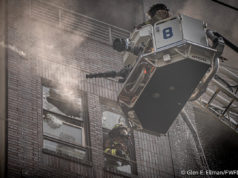Lots of spoilers lurk below. Be ye forewarned.
Of the many things HBO asks of House of the Dragon’s viewers — ignoring the awful wigs and the awful practices of incest and child marriage concomitant to the series’ plot — the expectation that we will just deal with the time-jumps in the story is probably the riskiest in terms of keeping us invested and up to date. After all, this was one of the main complaints surrounding the first season of The Witcher, whose title character’s magically arrested aging made a big, mid-season shift in eras particularly jarring. Luckily for us, House of the Dragon’s characters make a point to reiterate that the first and second episodes are, narratively speaking, half a year apart, with the death of Queen Aemma (Sian Brooke) in the first episode as the chronological marker. Hearing Rhaenyra (now played by Emma D’Arcy) remark that it’s been half a year since her mother died is a little clunky, but I’d prefer a single, leaden line of dialogue to having to guess what year it’s supposed to be.
Regardless of the “how,” a lot has happened during the “when” between the two episodes (including the thrilling debut of the series’ new title sequence, which echoes Game of Thrones’ clockwork map and repurposes that series’ main musical theme to dramatic, blood-pumping excitement). The pressure on King Viserys I (Paddy Considine) to remarry has increased. Prince Daemon (Matt Smith), commanded by Viserys at the end of the first episode to return to his wife in the Vale, has instead defied his king’s order, taking his paramour, Mysaria (Sonoya Mizuno), to the Targaryen’s ancestral stronghold of Dragonstone, along with a dragon egg.
And then there’s the matter of the Stepstones, an island chain under control of a Myrish warlord named Craghas Drahar. In the first episode, Lord Corlys (Steve Touissant) brings grim tidings to the king’s Small Council about Drahar’s assault on the Stepstones. Six months later, the warlord is an even bigger problem. Following an opening scene on a beach that is as objectively beautiful as it is gruesome, Corlys appends a nickname to Craghas Drahar that is appropriately chilling: Crabfeeder. In that first scene, we are treated to a shot of a balmy beach shrouded in mist, smoke, and the morning sun gleaming through the haze. Waves lap dreamily over the shore, their soft roar broken by the horrified screams of men bound and nailed to posts set into the sand, their flesh being eaten in real time by thousands of scuttling, pinching crustaceans. These men are Craghas Drahar’s victims, and the partly masked barbarian does not mess around.
Side note: I hope someone makes a YouTube video of this scene paired with “Under the Sea” from The Little Mermaid, but in any case, crabs are kind of gross already, and when they’re feeding on a live person’s open wounds, they’re straight out of a nightmare.
“Craghas Drahar” doesn’t sound so silly anymore, now does it? Everyone, this is the Crabfeeder. Crabfeeder, this is everyone. So that bit of sort of silly lore dump front-loaded into that initial running-the-realm part of the first episode turned out to be at least as ominous as the badly healed wounds King Viserys suffers all the time from literally sitting upon the Iron Throne. And by the end of the episode, when we get a glimpse of the unmasked Crabfeeder’s disfigured visage, the show does one of the things that the franchise does best: light our morbid curiosity about Westeros ablaze.
Apart from Crabfeeder’s despicable cruelty, his presence in the Stepstones is a problem because they sit astride a major shipping lane between the continents of Westeros and Essos. Corlys, lord of Driftmark and head of a house that is exceedingly wealthy because of its proximity to these islands, pitches a naval campaign to retake the Stepstones, but Viserys has no stomach for the casualties due upon bringing war into the Narrow Sea. Not for the first nor the last time, Corlys is pissed.
Now, I feel for the guy, because — as he divulges at the end of the episode in a fireside chat with Prince Daemon — Corlys Velaryon, Lord of Driftmark, comes from a Valyrian house even older than the Targaryens, and he and his ancestors have had to do a lot more heavy lifting than their dragon-riding countrymen. While the king’s forebears had the advantage of dragons, the Velaryons had to make due with whatever they could wring from the world with their own hands. Given that the Velaryons are known for their seafaring prowess and traditions, I assume that much of what they have wrung from the world are fish. Corlys, a.k.a. the Sea Snake, might be a legendary explorer, but he comes from a line that’s more or less the working men of the Valyrian noble houses, and this sticks in Corlys’ craw like a trout bone. Over a fireside chat at the end of the episode, he gripes to Daemon that both of them are “second sons.” Corlys is pissed because his house in general and his family in particular has continually been passed over and his most recent dealings with the king are just more slights added to the pile. Not only did Viserys give a hard pass on Corlys’ D-Day on Crab Beach idea, but he also passed on a pitch of even greater consequence: marrying Corlys’ daughter Laena (Nova Foueillis-Mosé).
Now, in Viserys’ defense, Laena, despite her unsettling understanding of a queen’s ultimate purpose, is only 12 years old. Considine does the awkward, off-putting scene with a keen balance between dutiful warmth and weary dismay for the proscriptions of succession, walking with his potential child bride, speaking to her as a person canny enough to grasp the stakes she is getting into. You might think that the king declining to marry a middle schooler means he’s not awful, but later, he announces his intention to wed Alicent Hightower (Olivia Cooke), the teenage daughter of his Hand and best friend of his daughter.
Once again, Corlys is pissed. He storms out of the chamber. But so does Princess Rhaenyra. Her arc in this episode shows her coming to terms with her father’s need to marry and sire an heir and actually talking about it with him, knowing that her own claim to the Iron Throne will be set aside with the arrival of a baby brother. Viserys insults both of them, because now he’s nullified House Velaryon’s shot at the throne and taken Rhaenyra’s best friend from her.
That Viserys does her dirty like that stings even worse because the understanding him and Rhaenyra come to — that he loves her and knows she is his worthy heir but still needs to try to father a son out of duty — is bolstered when Rhaenyra takes it upon herself to retrieve the stolen dragon egg despite Viserys’ expressed desire that she stay home. Viserys dispatches Otto Hightower (Rhys Ifans) and a contingent of knights — including the newest member of the Kingsguard, the Rhaenyra-appointed Ser Criston Cole (Fabien Frankel) — to deal with Daemon. Meeting the prince and his own cadre of Gold Cloaks atop the stone bridge leading to Dragonstone, Hightower’s force is um, forced to back down when Daemon’s dragon Caraxes climbs into view behind him. But then, the clouds beneath the bridge ripple, and Rhaenyra, riding her own dragon Syrax, emerges. And it is she who calls Daemon’s bluff. Her uncle tosses her the egg and returns to his castle. She returns to Viserys victorious, and for all his “I’m your dad, and that was dangerous and against my orders” bluster, he acknowledges his daughter’s mettle.
Unfortunately, all that good will fostered between Viserys and Rhaenyra are tossed into the proverbial trash, and in the scene where Viserys makes his fateful announcement, you can see the gravity of the moment on Alicent’s face. She doesn’t know it yet, but the war for succession between her sons and those of her former bestie will tear the kingdom apart, and the horrifying vision of men devoured by crabs is but a taste of the tragedy to come.












